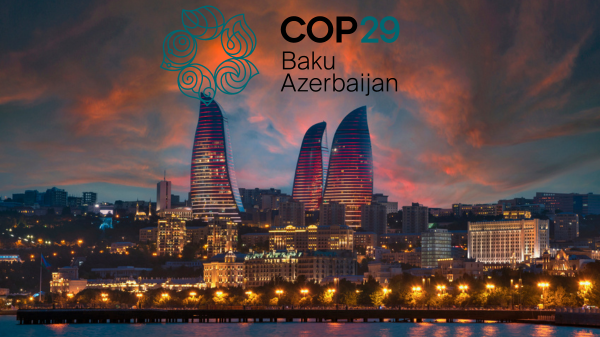IN THIS ISSUE:
- Climate Negotiations on Hold, Pending U.S. Elections
- Which Proxy Data Used in Reconstruction Matters
- Twenty-First Century Warming Driven by Cloud Decline, More Sun—Not Carbon Dioxide
Climate Negotiations on Hold, Pending U.S. Elections

No matter how big China’s economy has become and how outsized Russia’s influence on geopolitics has grown, the United States is still the straw that stirs the drink on climate policy, an article published in the Japan Times shows.
The article, “Trump stalks global climate talks as COP29 draws near,” describes the planning and negotiations, or more accurately the lack thereof, going on in the lead-up to the 29th Conference of the Parties to the UN Framework Convention on Climate Change (COP 29) to be held in Baku, Azerbaijan on November 11 through 22. Planning for these conferences, including settling on a theme or main focus, begins almost as soon as the previous year’s event ends, so a year of scheduling and planning goes into it.
In the run-up to each COP, nations send representatives to multiple meetings to establish the framework of topics to be discussed and to negotiate treaty language in anticipation of the lead negotiators arriving, so everyone will be on the same page. The main topic for this meeting is supposed to be (and not for the first time) “climate finance” (it’s always about money, isn’t it?): who pays (rich nations), who gets paid (developing countries), how much, on what timetable, and through what mechanism.
Despite advance agreement on the main topic of the conference, it seems the negotiations have gotten bogged down, in no large part because the payor countries are uncertain what the United States will do or what role it will play if Donald Trump gets reelected as president. The United Nations and most developing countries have argued over the years that the United States, as the biggest source of historical carbon dioxide emissions, should pay the most for climate reparations, mitigation, and adaptation. It hasn’t worked out that way under any administration so far, and Trump was by far the most recalcitrant on this point.
Trump continues to refer to climate change as a “hoax,” saying or implying China and other economic and geopolitical adversary and competitor nations are using the issue as a backdoor means of diminishing the United States, harming its economy, and reducing its influence globally. In keeping with that belief, Trump as president cut climate funding and programs, reprioritized policies to advance America’s interests over those of the “global community” concerned about climate change, implemented policies to unleash American energy dominance, and withdrew the country from the 2015 Paris climate agreement. If Trump is reelected president, COP 29 negotiators fear, probably rightly, that he will undercut the Biden administration’s commitments to policies intended to cut emissions sharply and to contribute a lot of money to various UN climate slush funds.
Japan Times describes the problems hampering significant climate negotiations in advance of COP 29:
The prospect of Donald Trump returning as president is hanging over crucial U.N.-sponsored climate negotiations, with countries “holding back” their positions until they know who sits in the White House.
Veteran observers of climate diplomacy say uncertainty over the election outcome is stalking this November’s COP29 summit, which starts just six days after voters decide between Trump and Kamala Harris.
The election lands awkwardly as governments try to build global consensus in coming months not just around climate but stronger protections for the environment and a treaty to address plastic pollution.
As president, Trump withdrew the United States from the Paris agreement on global warming—Joe Biden later rejoined the accord—and there are concerns over what his re-election might mean for climate action.
This year’s negotiations hope to increase money for poorer countries to handle climate change, but some governments have not proposed a concrete dollar figure, wary of committing too soon. …
This apparent wait-and-see approach has frustrated those seeking a new long-term commitment at COP29 from rich nations to pay the trillions of dollars needed for clean energy and climate adaptation in developing countries.
With just two months to go, there still isn’t an agreed definition of “climate finance” let alone how much should be paid, which countries should receive it and how, and who should be on the hook for it.
Wealthy donors historically obligated to pay, like the United States, European Union and Canada, have not put forward a figure, instead pushing for China and other big emerging economies to also chip in.
“Governments are holding back, and they’re trying to hedge their bets. Many of them don’t have a strong enough motive to move,” said Tom Evans, policy advisor at E3G, a think tank.
The U.S. election was “hanging over everyone, and it’s hard to look past that sometimes.”
Clearly, other developed nations can move forward with trillions in climate commitments without the United States participating, but no one wants to go first or be committed to spending scarce resources on a plan that the top industrialized nation is not also committing money to. Doing so would place them at a competitive disadvantage, something they won’t abide—even, evidently, at the risk of destroying the planet, which is what they claim is at stake without action.
This problem for COP 29’s negotiators is further complicated by the recent widespread grassroots rejection of various climate policies in EU countries, reflected in protests and electoral gains by climate realists and the replacement of presidents and prime ministers, both in member states and in the European Parliament. In Canada, meanwhile, the Trudeau government’s coalition has collapsed in disagreements over climate policies.
I have discussed what’s gone on in the EU previously, where right-of-center parties, some relatively newly arrived on the scene specifically in response to costly climate initiatives, have gained representation in various countries’ parliaments, some as the largest or at least the swing vote party, and where right-of-center leaders have come to power. One of the common policy threads through all these right-wing gains and victories is a rejection of the extreme climate commitments and policies imposed in response to past COP agreements. Nations have rolled back various climate crisis technology mandates and blocked new proposals.
The Heartland Institute has played a leading role in the EU’s shift on climate change. Austrian members of the European Parliament asked Heartland President James Taylor to deliver a presentation to members of parliament. After his talk and one-on-one meetings with various delegations, the EU defeated legislation mandating the European Union get to net-zero carbon dioxide emissions by 2050. Before Taylor’s talk and discussions, the proposal had been fast-tracked for approval.
Even the extreme, green, virtue-signaling government of our neighbor to the north is feeling the heat for pushing too far, too fast on extreme climate policies. With grassroots groups raising a ruckus with their local MPs, leading to shifts in local and regional elections, the Trudeau government lost its ruling coalition partner when Jagmeet Singh, leader of Canada’s New Democratic Party (NDP) withdrew from the governing coalition. The NDP’s support had been crucial to Trudeau’s climate initiatives, which have raised prices and cost jobs. The increasing backlash against these policies led Singh to end the NDP’s coalition agreement.
It is an open question whether Singh will now join the opposition Conservative Party’s call for a national carbon tax referendum, which, in the words of Conservative Party leader Pierre Poilievre, would allow Canadian citizens to decide directly “between the Costly Coalition of NDP-Liberals who tax your food, punish your work, take your money, double your housing costs and unleash crime and drugs in your communities OR common sense Conservatives who will axe the tax, build the homes, fix the budget, and stop the crime.”
Rising costs have led to a resurgence of the Conservatives, with the ruling Liberals losing previously safe seats in by-elections and polls showing the Liberals currently 20 percentage points behind the Conservatives if elections were called today.
COP 29 will still be held. After all, the ruling elites and bureaucrats will not forego their luxury junket to Baku—it’s the event of the season—but with the turmoil roiling the West it is unclear whether much will be accomplished besides the spewing of a lot of hot air from the attendees and carbon-dioxide emissions from their planes and cars.
And despite the impression that such an outcome would be bad for developing nations, those countries, who come with their hands out to each conference, are doing well amid climate change, with growing GDP’s and increasing crop production and human lifespans. The biggest threats to progress in the developing world are continued reliance on Western handouts with strings attached; government and financial climate policies and restrictions hampering fossil fuel use in Africa, Asia, and South America; and civil strife. Climate change isn’t harming the poor; climate policies are.
Sources: Japan Times; The Post Millennial; Climate Change Weekly
Which Proxy Data Used in Reconstruction Matters

Recent research published in the journal Science China Earth Sciences indicates that in working with proxy data to reconstruct past temperatures, “the selection of reconstruction methods and the selection of proxy records with different temporal resolutions over different regions” produces substantially different temperature reconstructions and trends over varying time periods. Tree-ring proxies, especially when the researchers limit the selection to only a sample of tree rings to analyze, produce different temperature reconstructions than samples of ice cores, shell middens, lakebed sediments, and mineral deposits that accumulate in caves.
To ensure uniformity of data and consistency of cataloguing, the researchers examined a wide variety of proxy data records to determine whether different datasets or composites of datasets would produce consistent temperature reconstructions for the past 2,000 years, or whether they would suggest dissimilar temperature trends at hemispheric and global scales.
Their analysis found that each of the varied different sets of proxy data indicate a long-term cooling trend over the past two millennia was consistently more pronounced in the non-tree-ring data. The cooling trend is larger in the Southern Hemisphere than in the Northern Hemisphere, but it is still global in nature. There were a variety of measurable differences between the tree ring proxies and non-tree-ring proxies. In particular, the researchers found,
Different reconstructions based on different types of proxies also exhibit different features in terms of volcanic responses and spectral properties. Tree-ring-based temperature reconstructions show stronger cooling responses to tropical volcanic eruptions, while non-tree-ring-based reconstructions suggest less robust volcanic responses. … Tree-ring width records tend to preserve a substantial proportion of high-frequency (<200 years) variability, whereas non-tree-ring proxies tend to capture a larger fraction of low-frequency (>200 years) variations.
In other words, trees are more sensitive in measuring relatively short-term atmospheric and climatic changes than non-tree-ring proxies, and the latter are more sensitive to longer-term, slower changes or trends.
Because trees ring data is more sensitive to short-term changes and trends, using proxy data only from tree rings is “pretty much guaranteed to conclude there were no warm periods in the past, even if other evidence exists showing that there were,” in the words of the author at Climate Discussion Nexus. This is especially true if those citing tree ring proxies to determine unusually high warming in the most recent century and a half drop the tree ring data from trees in the Northern Hemisphere when it begins to diverge downward from the measured temperature data, relying on only the Southern latitude data where cooling was more pronounced in the past, so any warming looks steeper.
The authors produced the temperature reconstruction graphic below which shows the differences between tree ring and combined non-tree-ring proxy data over the long term.

The green line represents the tree-ring-only global temperature reconstruction from AD 0 to 2000. The red line is the reconstruction based on non-tree-ring datasets. Clearly, other proxy data suggest temperatures were warmer than at present for extended periods of time in the past 2,000 years, and even the tree ring proxy data indicates that for relatively short periods of time temperatures at several points in the past were approximately the same as at present.
“Clearly the non-tree-ring records pick up warm periods in the past, especially during Roman and Medieval times, and the cold interval of the Little Ice Age,” writes Climate Discussion Nexus. “The 20th century is nothing special by comparison, and its warming trend is nothing compared to that in the 0-250AD interval. The tree rings by comparison miss all that detail.”
“But scientists tend to collect lots of tree ring records and not many of the other types, so if they just average together whatever they have at hand they will get a reconstruction like the green line and conclude that 20th century warming is unusual and unprecedented,” Climate Discussion Nexus concludes.
Thus, we get hockey sticks—the “official reconstruction” cited by the UN Intergovernmental Panel on Climate Change to the exclusion of other types of proxy datasets.
Sources: Climate Discussion Nexus; Science China Earth Sciences
Twenty-First Century Warming Driven by Cloud Decline, More Sun—Not Carbon Dioxide

A study published in Surveys of Geophysics suggests changes in cloud cover resulting in more sunlight reaching the Earth’s surface are responsible for much of the warming observed in the twenty-first century.
Satellite observations from the Clouds and the Earth’s Radiant Energy System conducted by a team of eight researchers from universities and research institutes in the United States, the United Kingdom, and France “show that Earth’s energy imbalance [the difference between incoming and outgoing solar radiation] has doubled from 0.5±0.2 Wm−2 during the first 10 years of this century to 1.0±0.2 Wm−2 during the past decade.
The increase is caused by more incoming sunlight or solar radiation reaching the Earth’s surface, warming both land and sea alike.
In particular, the scientists found
… large decreases in stratocumulus and middle clouds over the sub-tropics and decreases in low and middle clouds at midlatitudes are the primary reasons for increasing [absorbed solar radiation] trends in the northern hemisphere. These changes are especially large over the eastern and northern Pacific Ocean, and coincide with large increases in sea-surface temperature (SST).
In short, with less cloud cover of the types at issue, less shortwave radiation has been reflected back into space, resulting in more solar radiation reaching the Earth’s surface, causing warming.
The results of this study suggest the increase in sea surface temperatures (SST) over the past two decades can be traced to the decrease in cloud cover, and to the extent that rising SST has been responsible for the much-reported rise in surface temperatures (as claimed by NOAA before the Paris climate agreement negotiations), what with “boiling oceans” and all, there is little role for greenhouse gas emissions in the temperature increase. The latter point might suggest the various notable scientists who argue CO2 is saturated in the atmosphere and thus unable to drive more than a miniscule amount of further warming are correct and all the climate policies aimed at preventing emissions are misguided.
It’s the clouds and the Sun, stupid!
Source: No Tricks Zone; Surveys in Geophysics



